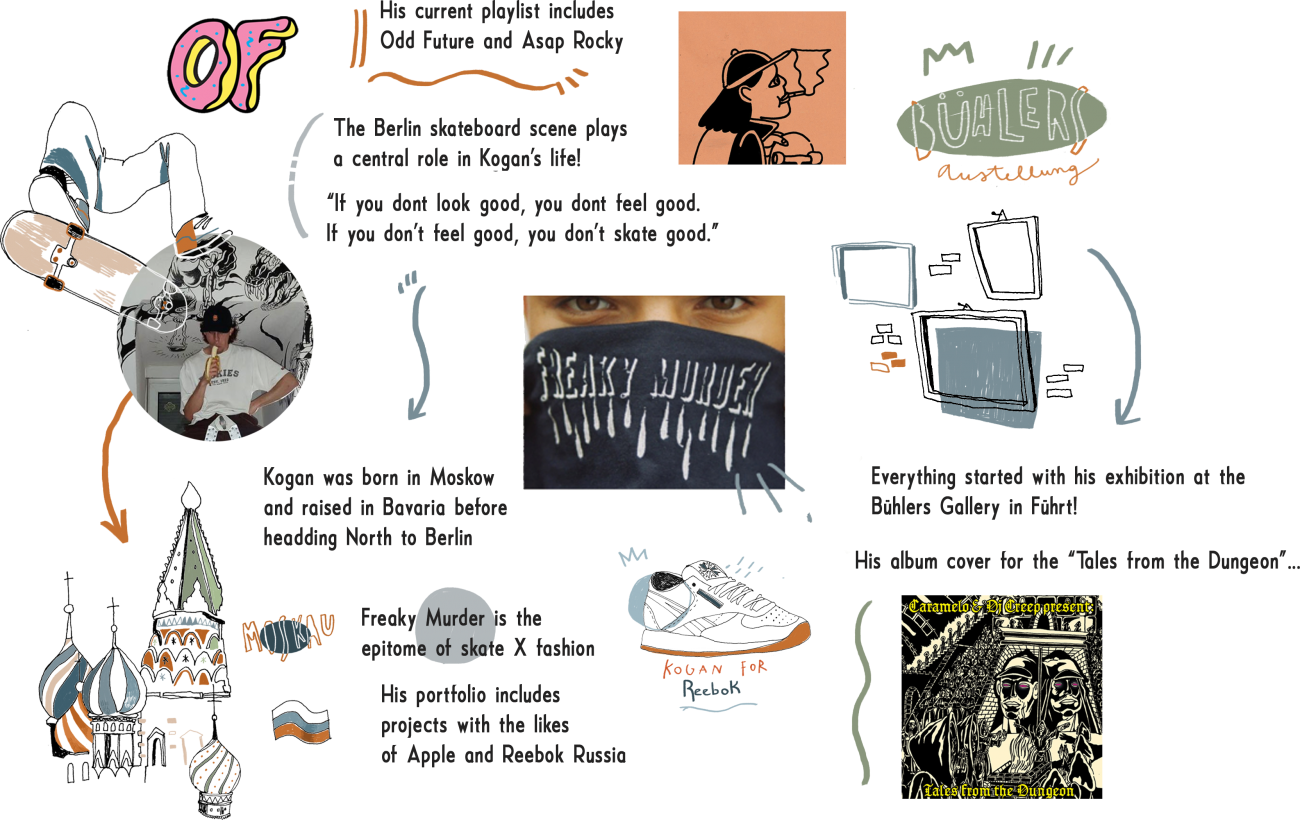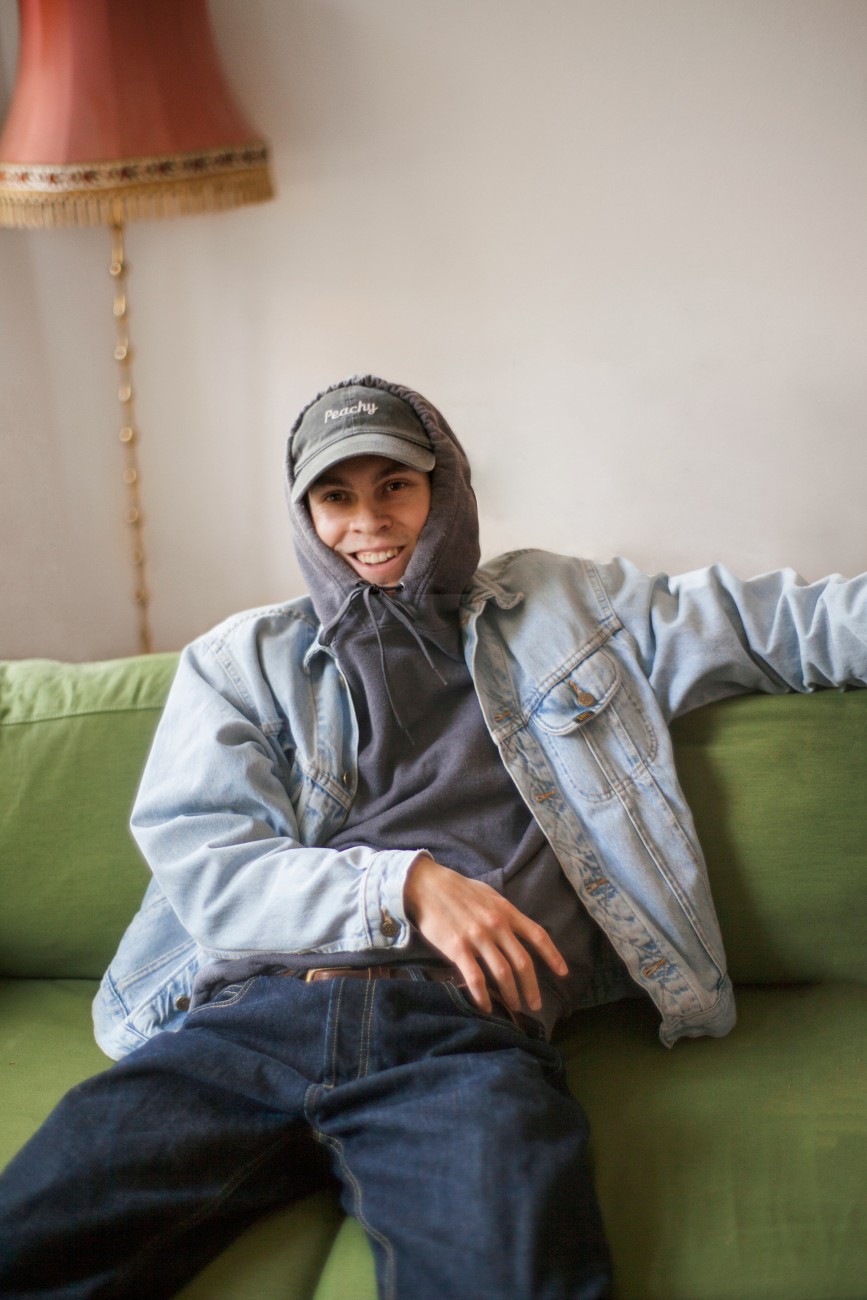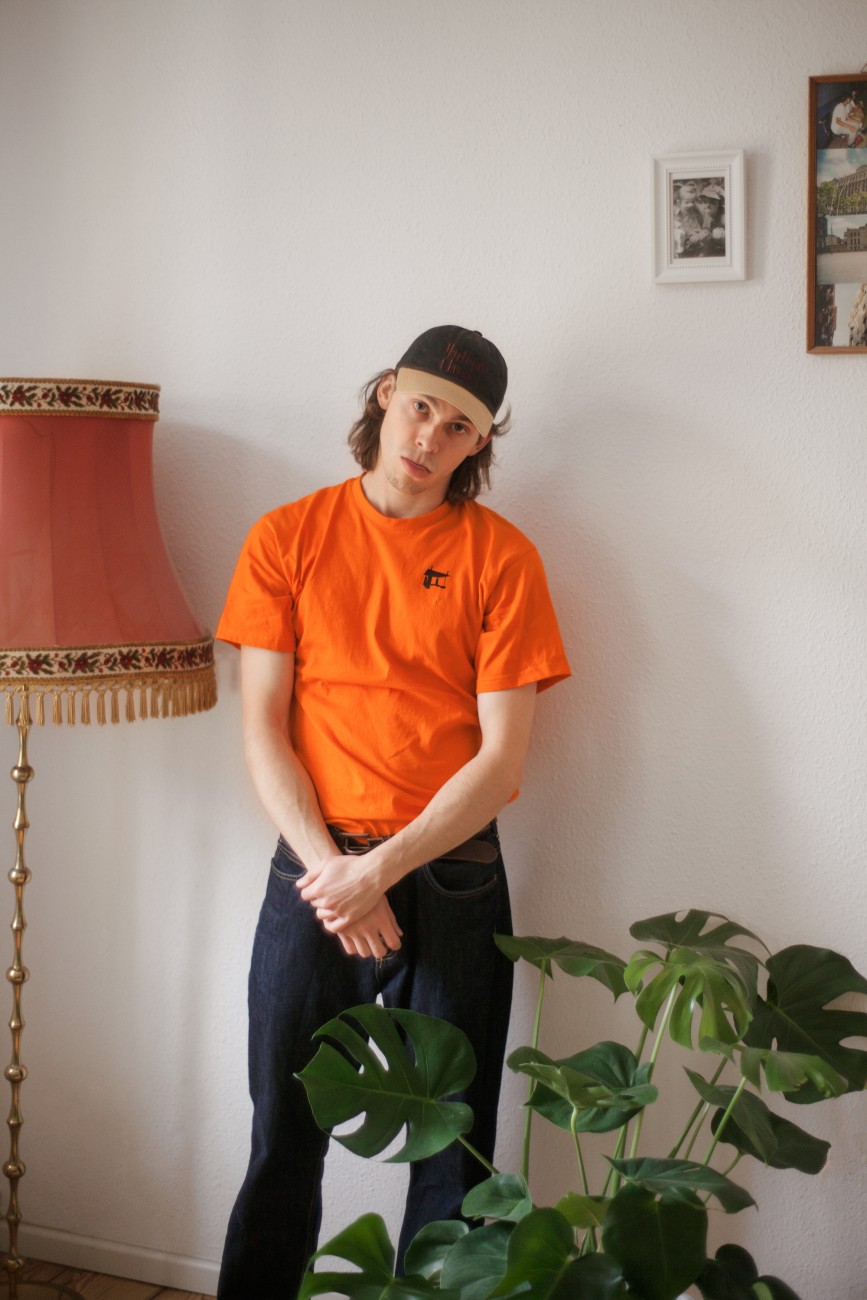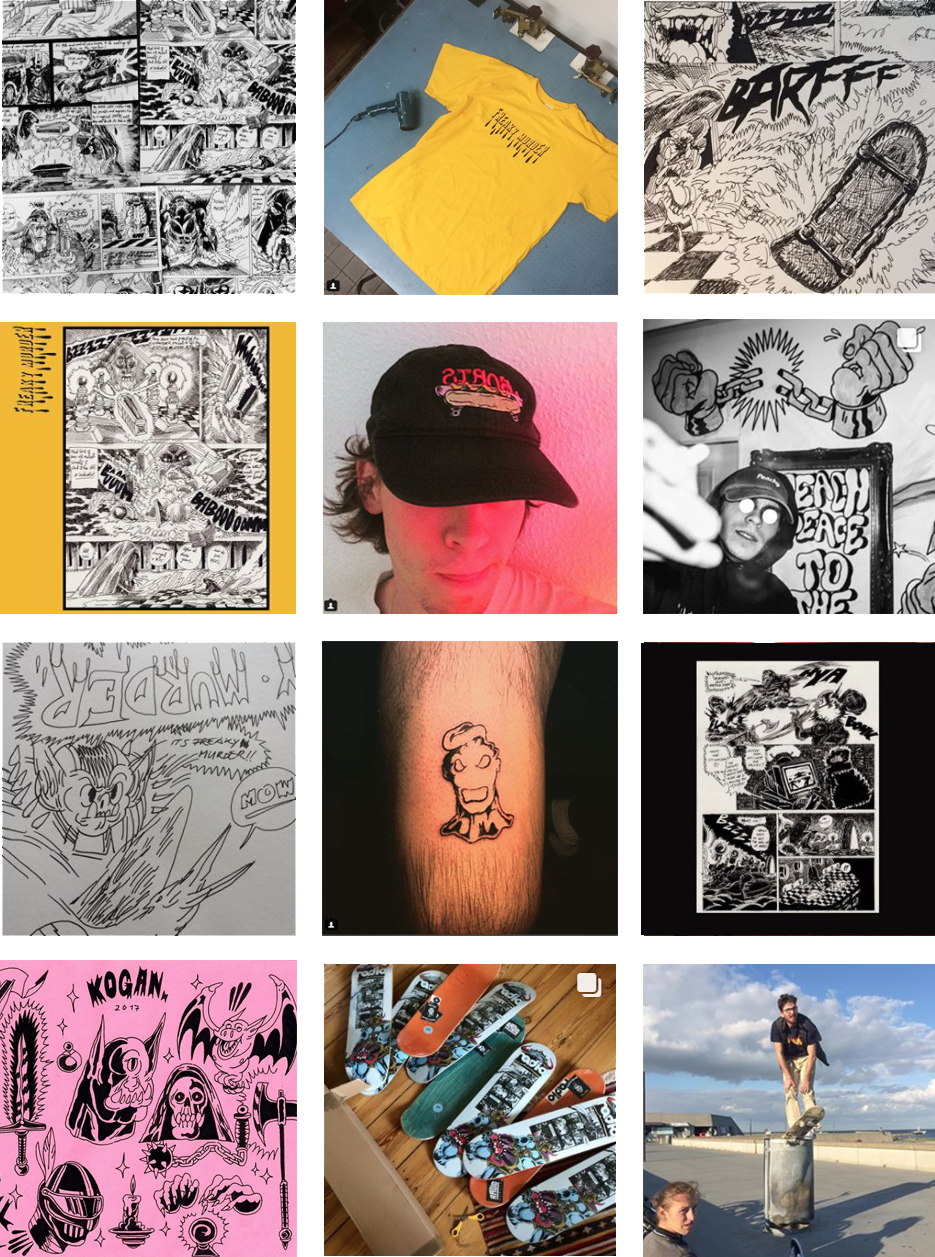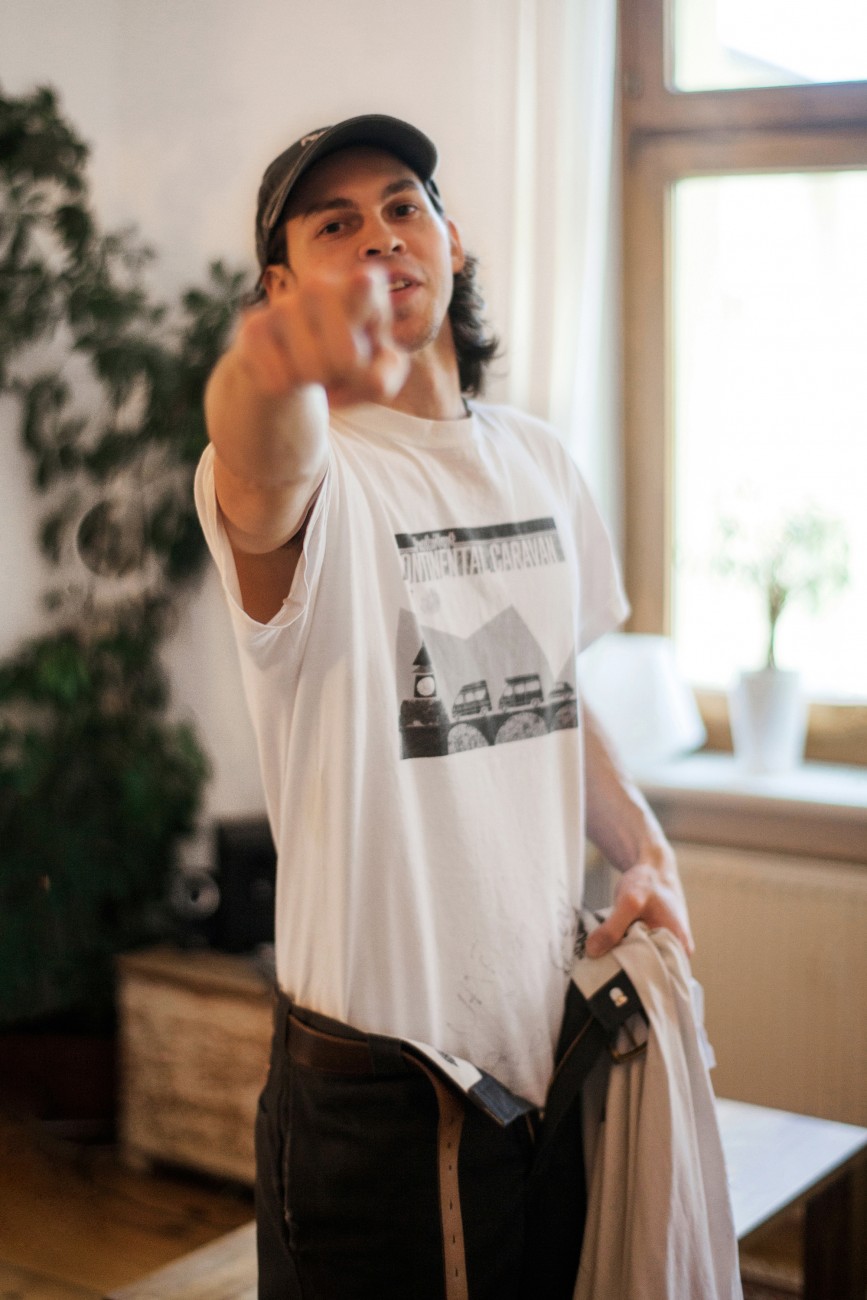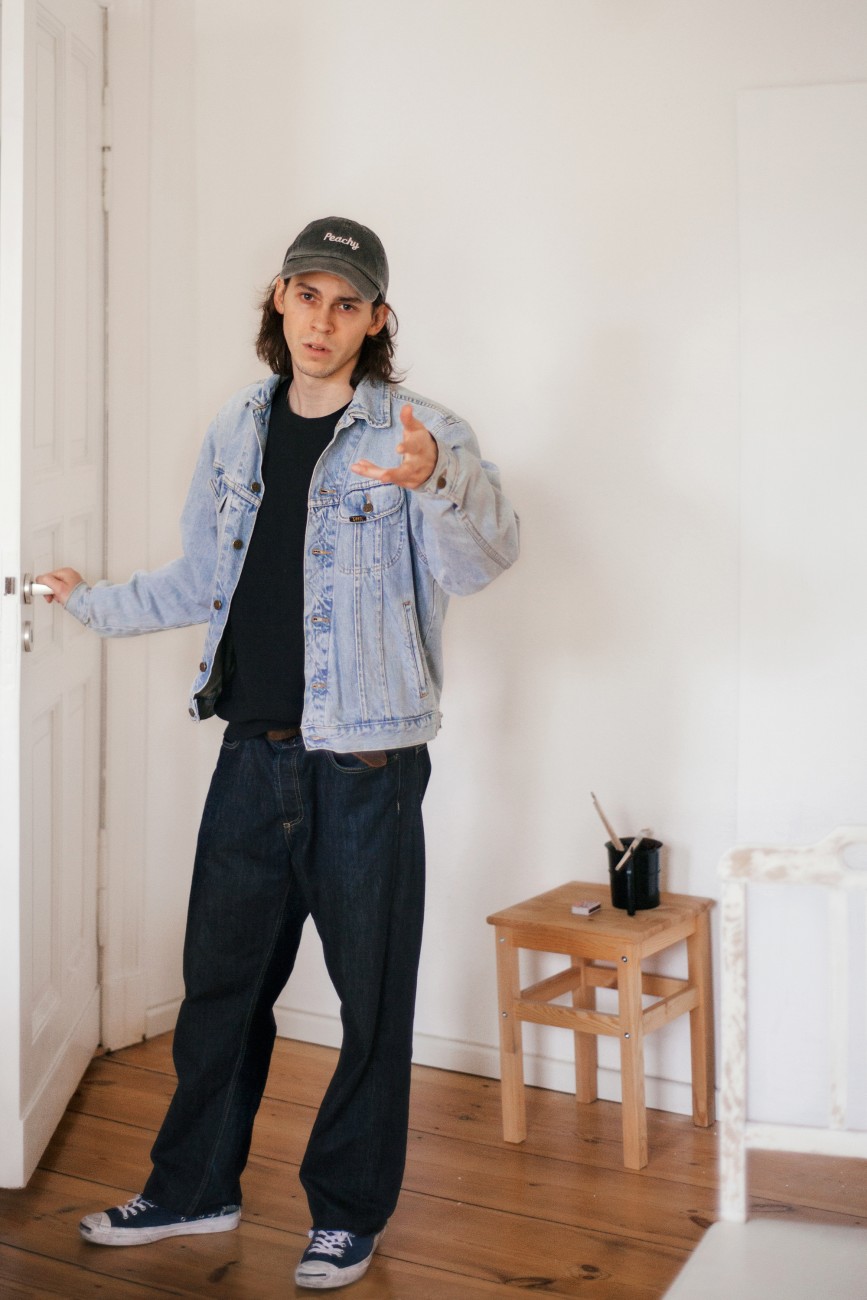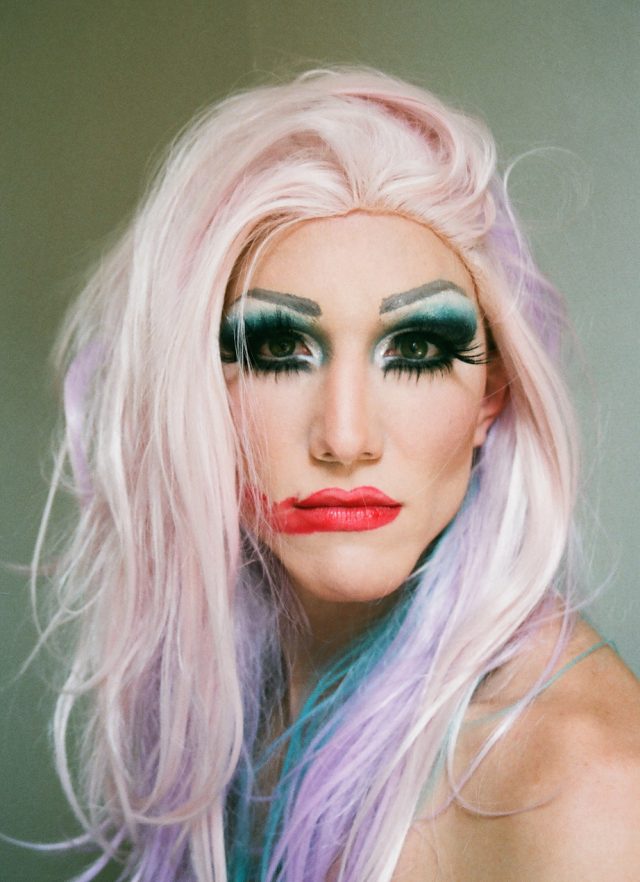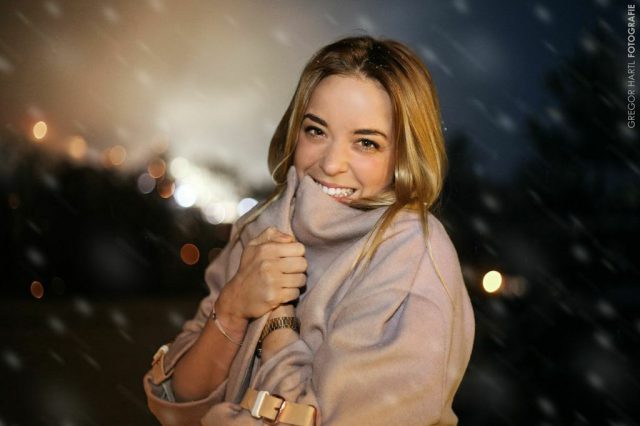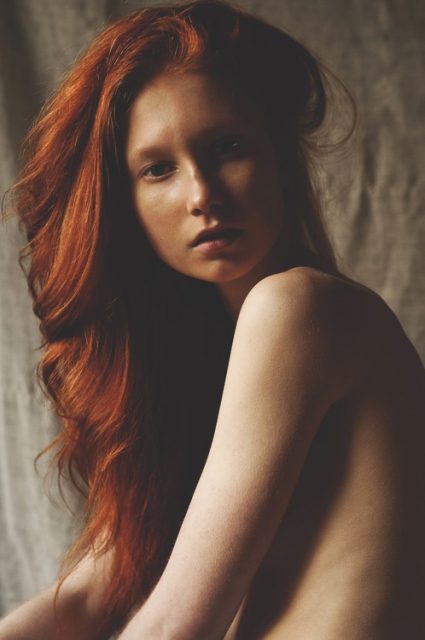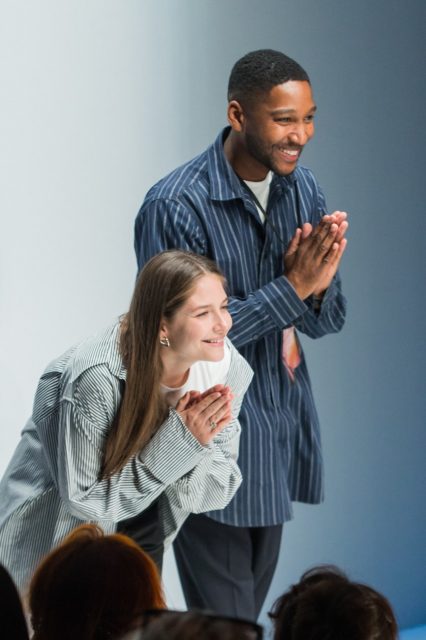Guys on Clothes is back to talk about skate culture! We sat down with Kirill Kogan, illustrator and—as of recently—tattoo artist, to understand how Skate & Destroy became Vogue’s “12 Skate-Inspired Summer Looks to Shop Now.”
Œ: Hello Kirill, thanks for meeting me. I’m excited to finally catch up with a skater!
Kirill: My pleasure! Although I don’t have a doctor’s degree in skateboarding, or fashion for that matter. Also, it’s a broad scene and subculture, so demographics vary a lot. My friends alone are very different types: some are fresh-out-of-jail, others are in law school…
Œ: Do you think it’s still a subculture?
Kirill: I guess it depends on what you define as “subculture.” Right now it’s definitely very trendy, so inevitably there’s the everyday-life dimension of skateboarding and a more stereotypical, even commercial, side to it.
Œ: Right! I recently came across Vogue’s “How to Do Skater Style Like a Model”… I was hoping we might get to the bottom of this difference. First of all, when and how were you introduced to skateboarding?
Kirill: I started when I was about fourteen. I grew up in Germany, but I’m Russian, and in Russia the parent-child relationship is very different—fourteen-year-olds are still very much considered kids. My mother was buying my clothes and I was often picked on for not looking cool. What’s more, my German wasn’t good, I didn’t get all the jokes and I didn’t grow up in a nice neighborhood, so it was hard for me to fit in and make sense of what was stylish and what was not. When skateboarding came into my life it was kind of magic: the first time I saw someone skating I didn’t understand the way it worked, the nature of the tricks, and how when he jumped the board stayed under his feet! I was enormously intrigued and eventually asked a kid in school if I could give it a try.
“Skaters tend to adapt clothing that reminds people of their infancy”
Of course I fell and hurt my knee, but from that moment on I wanted to learn. I convinced my mother to buy me a really cheap board from Kaufland, which was good enough to learn how to roll around and become familiar with the sport. Most importantly, I made new friends at school: I remember really admiring one of them, his spirit and the way he dressed. He was super funny, always telling jokes and rebelling against teachers.
Œ: Do you remember anything changing in the way you presented yourself? In the way you dressed?
Kirill: Skateboarding is all about trusting your body and your thoughts, and having the ability to translate them into movements. As a result, I started feeling less self-conscious about the things I actually liked, and developing a specific taste in clothing.
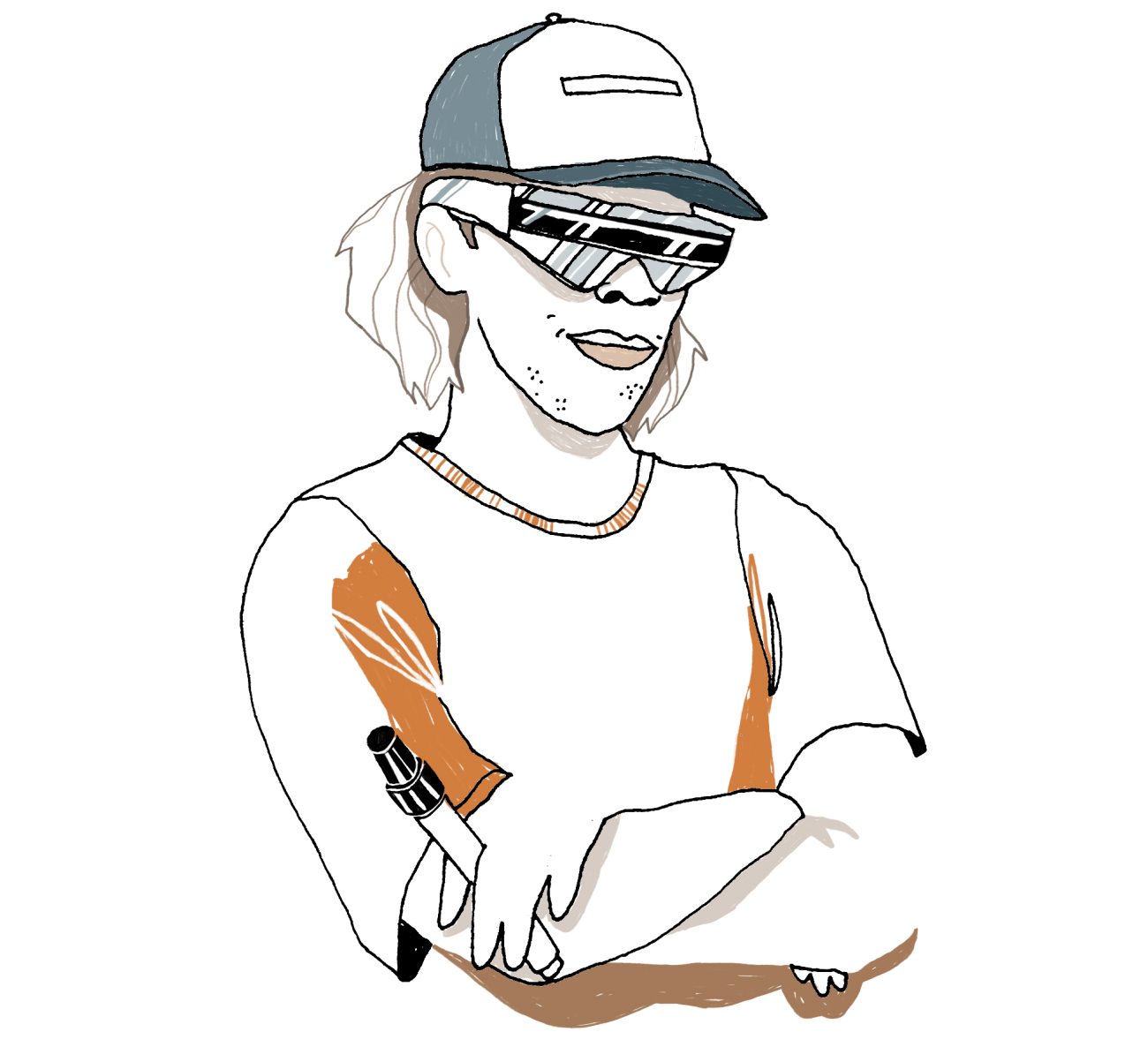
Kirill Kogan by illustrator Elena Scilinguo @elenza
Œ: Tell me about these clothes…
Kirill: I would wear nasty orange t-shirts with green lettering, for example. I think this attitude towards clothes also made me recognizable as a skater, you know, as part of a group.
Œ: What did this group, your group, have in common dress wise?
Kirill: Baggy grey hoodies, cargo pants, Vans, a beanie or a baseball hat.
Œ: Skate attire is one of the main influences on casual men’s wear. Do you have any idea why?
Kirill: I think it’s because there’s something free-spirited about the look—skater style is basically surfer style turned urban. It was inspired by blond West Coast dudes with flares, polo shirts, and Vans shoes. Generally speaking though, skaters tend to adapt clothing that reminds people of their infancy. I’m thinking of nerdy teenager accessories, printed band t-shirts, and dad caps. You know, these things become cool because skateboarding is ;) It’s not intentional trendsetting.
Œ: When did the look settle into what we know it as today?
Kirill: I’d say it started taking on its current shape in the 90s, given that’s when skateboarding became really popular. More kids started identifying with it to escape whatever conservative expectations of adulthood were thrown at them. At the same time it wasn’t nearly as multifarious as it is right now.
“If you don’t look good, you don’t feel good, and if you don’t feel good you will lack the confidence to skate well”
Œ: Are you referring to the fact that movements and subcultures are less militant when it comes to clothes today? A lot of people claim that most boundary-pushing with regards to men’s fashion belongs to the queer scene. What do you think? You hardly see skateboarders in tight miniskirts…
Kirill: Well, it’s a sport after all. It wouldn’t be very confortable! Plus, you can’t be homophobic if you’re a skater! You are constantly surrounded by dudes sweating and spend so much time commenting on shoes (laughs). If you find that off-putting, you’re in the wrong place. I think that skaters are just concerned with fashion in different ways. Maybe it’s less about identity and more about looking good in order to feel confident, and having the boldness to try out new tricks. A famous skater once said If you don’t look good, you don’t feel good, and if you don’t feel good, you will lack the confidence to skate well.
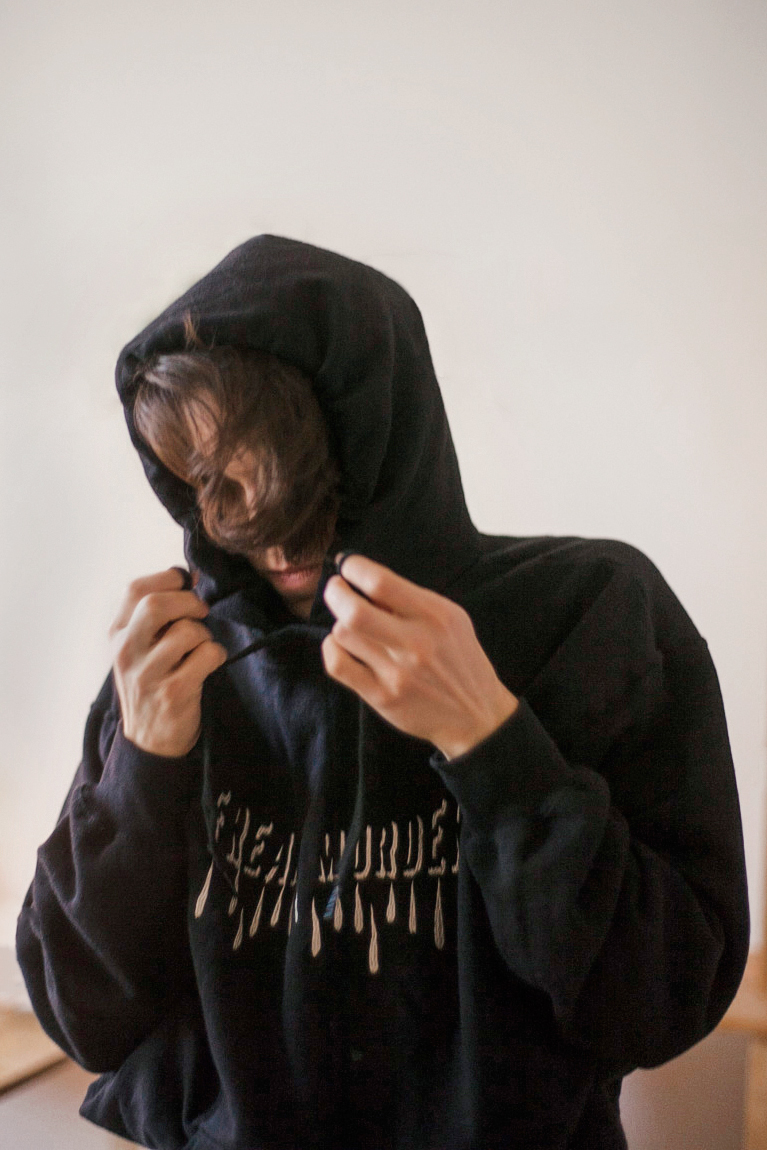
Œ: Fascinating! Do you feel that way about your skating?
Kirill: I wouldn’t necessarily put looking good, feeling good, and skating well in that order, but there’s definitely a connection. And I still think that today there’s a whole other degree to which it’s okay to be yourself. You can adapt to things from different movements and aesthetic backgrounds and make it your own! In the 90s you were either homologated to the norm, or homologated to not being homologated. For skateboarders that meant wearing baggy pants, listening to hip hop, and acting gangster.
Œ: How and when did black music and culture enter the picture? Didn’t you say that skating evolved from surfing…?
Kirill: Yes, there was a lot of punk rock and even electronic music going on, but at the end of the 80s hip hop and skateboarding had both reached enormous popularity. Skateboarding had found its way to the East Coast and become a lot more urban, so sportswear brands were addressing both cultures. Pro skaters were wearing hip hop t-shirts, shoes that were originally designed for basketball players, while rappers had begun skating! That’s how the two cultures converged.
Œ: I see! Indeed, I always had more of a punk rock and HC association. Is there some kind of divide between skaters listening to punk rock and skaters listening to hip hop today? Is this a topic of discussion among your friends?
Kirill: I’m sure it was when we were teenagers. But skateboarding has always been very inclusive, so you will find elements of muted surfer rock, punk, as well as hip hop influences. Plus, everyone is grownup now, and things are a bit more fluid. Personally, I listen to trap, surfer tunes, and electro. But I definitely see how people could get worked up over these things back in the day.
Œ: What happens when a subculture’s wardrobe becomes mainstream? And do either you or your skater friends have feelings about labels referencing skate culture or Gosha Rubchinskiy launching Skate-Scented Fragrances?

Kirill: Of course some people are irritated and hate on brands like Nike and Gucci. I tend to stay neutral and observe because I really skate for the sake of it. We all listen to hip hop, we all listen to ASAP Rocky, and it doesn’t really matter that he’s wearing the biggest brands out of sponsorship!
“In the 90s you were either homologated to the norm, or homologated to being homologated”
I guess the worst thing I saw this year was a non-skater “dressed up” as one—I could tell he didn’t actually skate because everything he was wearing was brand new. The man was just digging the style and normally I’m cool with that because it’s a form of appreciation, but this particular guy was even carrying a skateboard…as if it were a purse! Just to make the look complete.
Œ: That’s to say that despite not conforming to a certain norm, skaters are currently informing men’s standard wear more than any other street culture! Do you think social media has affected or changed skate identity in a significant way? I believe you have an Instagram account.
Kirill: I’m sure it has, although my creative output on social media is way higher than my “skating output.” Skating is something I keep to myself and cultivate with my friends, you know? I don’t want to be “out there” with my skateboarding. With my art it’s different: I’m somewhat militant about it because it’s my life and it’s what I want to share with people. I think social media is great because of the reach. Of course there is the problem of originality. But it’s also great because you don’t need to travel as much anymore to get inspired. And as long as you stay critical about it, you can really find gold on the internet!
Œ: How has social media affected the notion of belonging? Belonging to a scene for example? There are plenty of ways of manifesting affiliation virtually, without physically “showing up” somewhere…what do you think?
Kirill: Well, the advantage is that unlike ten years ago, if you hurt your knee you can still be part of a community and cultivate a life-style through these channels. Of course, the downside is that some people might be tricked into thinking they’re skaters just because they watch one hundred skating videos, or dress up as one, like the dude I was telling you about.
“Skate parks really take you back to a stage of infancy and wonder”
If I may ask you a question: what is your personal idea of a skater? If you hadn’t talked to me and assuming the media you consume is not skateboarding specific.
Œ: (laughs) Admittedly yes. But I also had skater friends growing up. Based on my previous impressions and prejudice, I can only say that skaters are stubborn personalities! In my experience, they see the world as a giant playground and stay skeptical about growing up long after having reached adulthood! (laughs)
Kirill: (laughs) Well, having fun at our age is a hard job! You know, there is this saying “the best skateboarder is not the one with the sickest tricks but the one who is having the most fun,” and I think there is some truth to it! The thirty-year-old guy having the time of his life at the skate park probably needs to wear a suit at work! In this sense, skate parks really take you back to a stage of infancy and wonder, where one can put grown-up life on hold. And I believe that clothing—the hoodie and the chucks—are key to accessing that mindset and freedom.
Œ: Does this apply to you?
Kirill: Absolutely. It’s funny, the other day I was telling a friend that not too long ago I enjoyed showing up at parties in my skating clothes, wearing them outside the skatepark. I guess I liked making a point about it—the statement being I was skating the whole day and I couldn’t be bothered to change into something that others might perceive as more appropriate. Of course these are childish motives, but it was fun, and sometimes I still like doing it.
Œ: It does sound fun! I might have to try it out after all. Thanks for sitting down with us, Kirill!
.
